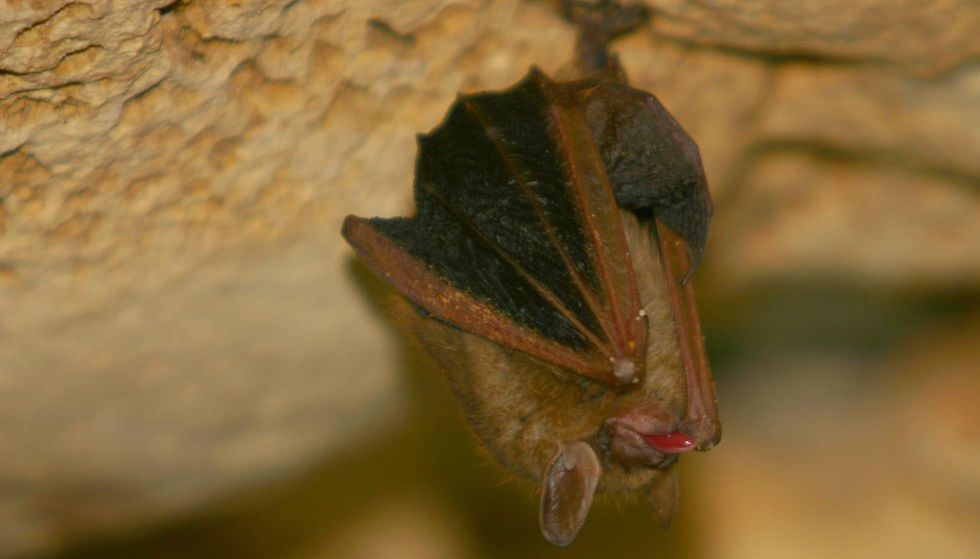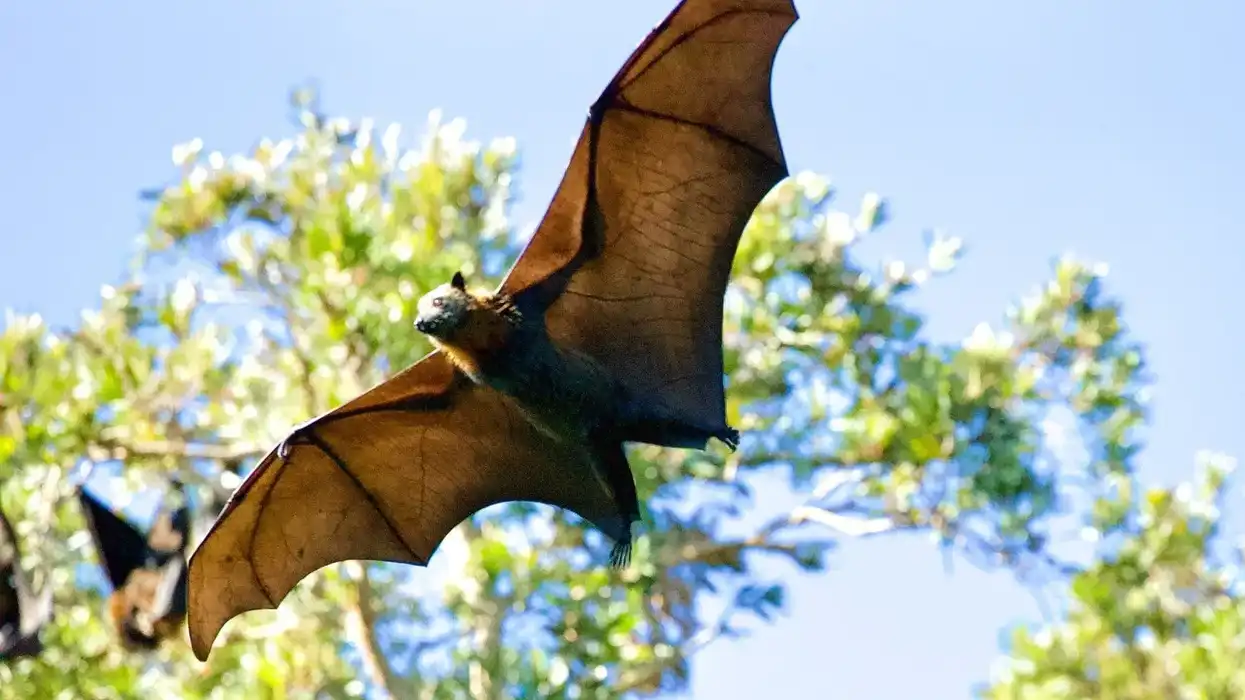Eastern red bats are mammals (bat species) from the Vespertilionidae family. The location where these bats can generally be found is in the United States (Southern parts of Canada into Chile and Argentina).
Red bats' conservation status is considered to be of Least Concern, yet they are also Endangered in several countries. Eastern red bats are generally found in forested regions. During the daytime, they sleep in the trees, rock crevices, caves, and buildings.
Eastern red bats are active during the night time. These bats use their wings to fly, and also use them to catch their prey, such as small flying insects.
Their wing membranes are blackish and the top of their tail membrane is furry. They have brick red and yellowish-red fur, which is white at the tips, giving them an appealing and attractive look. The females are appealing and attractive as well.
Red bats (Lasiurus borealis) prefer living within their own groups, also known as colonies. Red bats hibernate in a hollow tree and leaf litter, though the latter place of hibernation subjects them to danger.
If you like reading about red bat and red bat migration facts, you could also check out our articles on hoary bat or striped skunk.
Red Bat Interesting Facts
What type of animal is a red bat?
Red bats belong to the Vespertilionidae family. They are one of the species of bats.
Red bats are also known as eastern red bats with the scientific name Lasiurus borealis. Eastern red bat (Lasiurus) are generally found in forested regions. The location where one can usually spot them is the United States (Southern parts of Canada all the way through Central America and then into Chile and Argentina).
What class of animal does a red bat belong to?
The eastern red bat belongs to the mammal class. The females of the red bats give birth to the young ones and feed them with their own milk.
Eastern red bat (Lasiurus) have warm blood which helps them maintain body temperature and blood circulation. They use their wings to fly and also use them to catch their prey and small flying insects.
How many red bats are there in the world?
There is no exact number or population provided as a relevant study is yet to be conducted. Their conservation status is Least Concern, but they are also Endangered in many countries.
Where does a red bat live?
Eastern red bat species are generally found in the forest edges of USA, southern Canada and Central America. During the day time, they sleep in trees, rock crevices, caves, and buildings.
Eastern red bats are active during the night time which is why they are considered to be nocturnal. They fly near lakes, ponds and use their lower jaw for drinking water.
What is a red bat's habitat?
Eastern red bats are generally active during the night time and sleep during the daytime, usually in deciduous trees, but sometimes they prefer coniferous trees. They are medium-sized, and their habitat is commonly spotted in the southern parts of Canada.
They can also be spotted around street lamps, as they prefer well-lit areas for eating small flying insects. Predators of red bats include birds of prey and opossums. They prefer living in forested areas, woody areas, and near lakes or ponds.
Who do red bats live with?
Red bat (Lasiurus borealis) species prefer living with their own groups (known as colonies). The size of these colonies can range anywhere between 100 to thousands of individual bats. You can find them around forest edges, hollow trees, around street lights, and clearings. They shift to warmer areas during winter.
How long does a red bat live?
Their lifespan is 12 years. Their survival depends on many factors like predators, diet and diseases.
How do they reproduce?
Females of the red bat (Lasiurus borealis) species have four mammary glands, whereas other bats have two. Females usually store the males' sperm and try not to get pregnant until the breeding season begins around spring, between March and April. The mating occurs usually in the months of August and September.
The female bat gives birth to one litter of twins annually, while the other species of bats typically give birth to only one. The newborn baby bat is very cute.
They are hairless and weigh virtually nothing. They learn to fly when they are just five weeks old. They also stay hung onto their mothers with one foot and another foot on a perch.
What is their conservation status?
They officially come under the category of Least Concerned, but in some areas and countries, they are Endangered.
Red Bat Fun Facts
What do red bats look like?
Eastern red bats are medium-sized, having a total length of 1.4-1.9 in (40–50 mm). They weigh approximately 0.01-0.02 lb (7–13 g).
They have red and yellowish-red color fur, which is white at the tips, giving them an appealing and attractive look. Males of the red bat species are usually more red in color than females. But, the female bats look more frosted than the male bat.
You can also see that the tail membrane has a thick fur running along the upper side, keeping itself warm during winter. When the winter temperature drops below a certain threshold, red bats will go into hibernation. Red bats have 32 teeth, and there is no difference in sizes.
When they hang upside down, they look like dead leaves or pine cones. The young bats learn to fly after five weeks.

*Please note that this is a picture of a tri-colored bat, not a red bat. If you have a picture of a red bat please let us know at hello@kidadl.com
How cute are they?
Red bats are very cute and adorable, especially the young ones. Female red bats are more appealing than males. They are of medium size with cozy whitish fur, which they also use to keep themselves warm during winter. They have brick reddish or yellowish-red fur and use one foot to hang. When they hang they look like dead leaves.
How do they communicate?
Eastern red bats use echolocation to locate prey. These bats usually live in large groups known as colonies that consist of around 100 to 1000 bats.
How big is a red bat?
Eastern red bat facts show that they are generally 3.7-5 in (95–126 mm) tall and 1.4-1.9 in (40–50 mm) in length.
How fast can a red bat move?
Bats are the only mammals to have the advantage of sustained flight instead of gliding, like the flying squirrel. But, no known record is found about the red bats flight speed.
How much does a red bat weigh?
Red bats are neither too big, nor too small. They fall under the category of a medium-sized bat at 0.01-0.02 lb (7–13 g).
What are the male and female names of the species?
There is no specific name for the male and female species. The males are known as 'male red bat' and females are known as 'female red bat'.
What would you call a baby red bat?
Young bats are known as pups. They learn to fly after five weeks and hang on to their mother with the help of one foot. They are hairless, tiny, cute, and adorable when they are born.
What do they eat?
Red bats come under the category of insectivorous. Red bats eat small insects, primarily moths and beetles. They are not usually active during day time.
The male bat comes out from hibernation searching for food, especially during warm winter evenings or mid-afternoon, compared to the females who do not follow this feeding time pattern. They usually hunt in well-lit areas, making it easy for them to catch insects attracted to any light source.
Red bats eat several different kinds of insects including moths, beetles, plant-hoppers, ants and flies.
Are they dangerous?
They may be dangerous to humans as they are quite capable of inflicting bite wounds, and under threat, they might resort to biting.
Would they make a good pet?
No, they will not be an ideal pet for humans. Their habitats are quite different from what we can provide. They are best left in the wild where they can flourish in their colonies.
Did you know...
Eastern red bats are tree bats rather than cave bats as they hang on using one foot, and it is hard to spot them on a tree during roosting because they look identical to dead leaves.
Why is the red bat endangered?
Migration and weather issues are some of the reasons they are becoming endangered. Another reason is the disease named white-nose syndrome, which is the cause of many bat deaths in North America. This has caused a decline in the Eastern North American bat populations at hibernation sites since 2007. These bats are endangered only in specific areas and countries.
Why is the red bat important?
Red bats are important as they consume a large number of insects that are categorized as pests, bringing down the insect population that usually causes a variety of problems to humans if kept unchecked.
Here at Kidadl, we have carefully created lots of interesting family-friendly animal facts for everyone to discover! Learn more about some other mammals, including mexican free-tailed bat or two-toed sloth.
You can even occupy yourself at home by drawing one of our Red Bat coloring pages.










